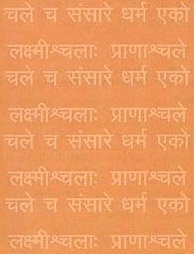Pragabhava, Prāgabhāva, Pranc-abhava: 9 definitions
Introduction:
Pragabhava means something in Hinduism, Sanskrit, Jainism, Prakrit, Marathi. If you want to know the exact meaning, history, etymology or English translation of this term then check out the descriptions on this page. Add your comment or reference to a book if you want to contribute to this summary article.
In Hinduism
Nyaya (school of philosophy)
Source: Shodhganga: A study of Nyāya-vaiśeṣika categoriesPrāgabhāva (प्रागभाव) refers to “antecedent non-existence” and represents one of the four types of abhāva (non-existence) according to Annaṃbhaṭṭa’s Tarkasaṃgraha.—Prāgabhāva is the abhāva of a thing in its inherent cause, before its production e.g., a jar is made from its two parts. The prāgabhāva of the jar is found in its parts. When the jar is made, the prāgabhāva of the jar is destroyed. So, prāgabhāva has no beginning but it has an end. If the prāgabhāva is not destroyed, any effect will never be produced. Annaṃbhaṭṭa defines prāgabhāva as that which has no beginning but has an end. It remains prior to the production of an effect. Śivāditya gives the same definition of it. Viśvanātha defines prāgabhāva in his Nyāyasiddhāntamuktāvalī that prāgabhāva is destroyable. According to Keśava Miśra, that is known as prāgabhāva which iexists in the cause before the production of the effect.

Nyaya (न्याय, nyaya) refers to a school of Hindu philosophy (astika), drawing its subject-matter from the Upanishads. The Nyaya philosophy is known for its theories on logic, methodology and epistemology, however, it is closely related with Vaisheshika in terms of metaphysics.
In Jainism
Jain philosophy
Source: archive.org: Anekanta Jaya Pataka of Haribhadra SuriPrāgabhāva (प्रागभाव) refers to “antecedent non-existence” and represents one of the four kinds of Abhāva (“non-existence), as used in the Anekāntajayapatākā-prakaraṇa, a Śvetāmbara Jain philosophical work written by Haribhadra Sūri.—[Cf. Vol. I, P. 17, l. 29]—Before a thing (say a jar) is produced, there is its non-existence. This non-existence is prāg-abhāva. It exists from beginningless time, and it is destroyed as soon as a thing of which it is a prāg-abhāva is produced. The word ‘prāg-abhāva’ occurs in Vol II, on p. 31, ll. 8-9 and on p. 173, l. 6. It is explained in the super-commentary (Vol. II, p, 31). Further, a quotation by way of its illustration is given there. It means: the non-existence of dadhi (curd) kṣīra (milk) is called ‘prāg-abhāva’.
-
Languages of India and abroad
Marathi-English dictionary
Source: DDSA: The Molesworth Marathi and English Dictionaryprāgabhāva (प्रागभाव).—m S (prāk & abhāva) Antecedent non-being. See abhāva.
Marathi is an Indo-European language having over 70 million native speakers people in (predominantly) Maharashtra India. Marathi, like many other Indo-Aryan languages, evolved from early forms of Prakrit, which itself is a subset of Sanskrit, one of the most ancient languages of the world.
Sanskrit dictionary
Source: Cologne Digital Sanskrit Dictionaries: Shabda-Sagara Sanskrit-English DictionaryPrāgabhāva (प्रागभाव).—m.
(-vaḥ) Antecedent privation, the non-existence of any thing which may yet be. In law, the non-possession of property that may be possessed. E. prāk prior, a negetive and bhāva being.
Source: Cologne Digital Sanskrit Dictionaries: Benfey Sanskrit-English DictionaryPrāgabhāva (प्रागभाव).—i. e. prāk-a -bhāva, m. The non-existence (of any effect) previous to production, Bhā- ṣāp. 11.
Source: Cologne Digital Sanskrit Dictionaries: Monier-Williams Sanskrit-English Dictionary1) Prāgabhāva (प्रागभाव):—[=prāg-abhāva] [from prāg > prāñc] m. the not yet existing, non-existence of anything which may yet be, [Bhāṣāpariccheda; Sāṃkhyakārikā, [commentator or commentary] etc.]
2) [v.s. ...] (in law) the non-possession of property that may be possessed, [Horace H. Wilson]
Source: Cologne Digital Sanskrit Dictionaries: Yates Sanskrit-English DictionaryPrāgabhāva (प्रागभाव):—[prāga+bhāva] (vaḥ) 1. m. Non-existence of what may be; non-possession.
[Sanskrit to German]
Sanskrit, also spelled संस्कृतम् (saṃskṛtam), is an ancient language of India commonly seen as the grandmother of the Indo-European language family (even English!). Closely allied with Prakrit and Pali, Sanskrit is more exhaustive in both grammar and terms and has the most extensive collection of literature in the world, greatly surpassing its sister-languages Greek and Latin.
See also (Relevant definitions)
Partial matches: Prag, Pranc, Abhava.
Starts with: Pragabhavakhandana, Pragabhavakhandanavicara, Pragabhavavada, Pragabhavavicara, Pragabhavavicararahasya, Pragabhavavijnana.
Full-text: Pragabhavavada, Pragabhavavicara, Pragabhavavicararahasya, Pragabhavavijnana, Abhava, Pragabhavojjivana, Pirakapavam, Samsargabhava, Atyantabhava.
Relevant text
Search found 21 books and stories containing Pragabhava, Prāgabhāva, Pranc-abhava, Prāg-abhāva, Prāñc-abhāva, Prag-abhava; (plurals include: Pragabhavas, Prāgabhāvas, abhavas, abhāvas). You can also click to the full overview containing English textual excerpts. Below are direct links for the most relevant articles:
Nyaya-Vaisheshika categories (Study) (by Diptimani Goswami)
Abhāva (1): Prāgabhāva < [Chapter 7 - Abhāva (Non-existence)]
Varieties of Abhāva (Introduction) < [Chapter 7 - Abhāva (Non-existence)]
Abhāva (3): Atyantābhāva (Absolute Non-existence) < [Chapter 7 - Abhāva (Non-existence)]
A History of Indian Philosophy Volume 3 (by Surendranath Dasgupta)
Part 4 - The Pramāṇas according to Mādhava Mukunda < [Chapter XXI - The Nimbārka School of Philosophy]
Part 17 - Rāmānujācārya II alias Vādi-Haṃsa-Navāmvuda < [Chapter XX - Philosophy of the Rāmānuja School of Thought]
Taittiriya Upanishad Bhashya Vartika (by R. Balasubramanian)
Verse 1.31 < [Book 1 - Śīkṣāvallī]
Verse 1.32 < [Book 1 - Śīkṣāvallī]
Verse 2.179 < [Book 2 - Brahmavallī]
Vivekachudamani (by Shankara)
Vakyapadiya of Bhartrihari (by K. A. Subramania Iyer)
Verse 3.9.56 < [Book 3 - Pada-kāṇḍa (9): Kāla-samuddeśa (On Time)]
Nyayakusumanjali of Udayana (study) (by Sri Ramen Bhadra)
Further analysis of the Argument < [Chapter 2 - The first and second Stavakas]